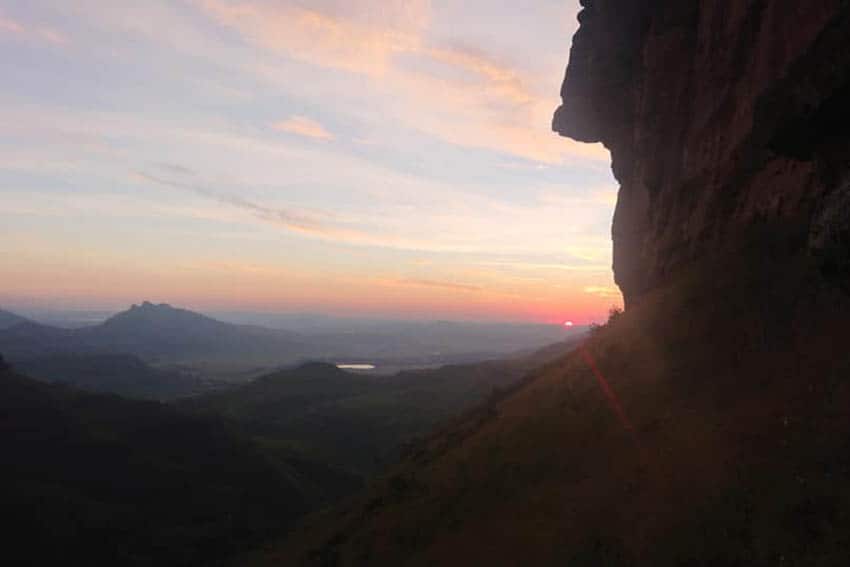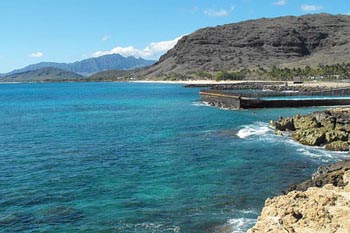
Knysna: What a Surprise in South Africa!

By Noreen Kompanik
GoNOMAD Senior Writer
“This does not look like South Africa” I surprisingly exclaimed as my husband and I stood overlooking the Knysna Heads, the sandstone headlands of two peninsulas that enclose and form the Knysna River Estuary – also the storied meeting place of the Atlantic and Indian Oceans.
Our group of travelers stood in awe overlooking these stunning views before us – a complete and total surprise to what we had imagined South Africa in our minds.
In addition, I was so excited to be seeing the Indian Ocean for the first time in my life.
It’s true that most visitors venture to South Africa for its savannahs, game drives and to witness its exceptional wildlife, whether antelope or penguins.
But South Africa is blessed with a temperate climate making its beaches and mountain regions equally appealing with such immense beauty that it’s an amazing year-round destination filled with so much diversity.
Traveling to the Featherbed Nature Reserve
In order to get to our planned destination of the day – the Featherbed Nature Reserve, we boarded a ferry from the Knysna Waterfront (pronounced nyzna), located on the stunningly picturesque Garden Route in South Africa’s Western Cape Province, only a few hours from Cape Town.
The 25-minute calm and relaxing ferry ride across the Knysna Lagoon provided some lovely views accompanied by a narrated history of the region’s early shipping industry and oyster cultivation before we arrived at the company’s terminal at the Reserve.

From this point, our trip up the mountain to the clifftop was quite a fascinating one, traveling in a cart pulled by a 4-wheel drive Unimog – a bumpy, off-road vehicle used for navigating challenging terrains.

Panoramic Views to Die For

Our guides promised we’d make a surprise stop along the way to the top of the Western Head that would provide incredible photo ops, though the drive had already been providing many “honey, stop the car moments.”
But when we arrived at our designated stop-off point, you could hear a pin drop. All passengers were not only awe-struck, it was difficult for anyone to come up with the words the describe the scenery that materialized before our yes.

Two massive sandstone cliffs and the channel below were immensely beautiful and wild, but they have a more sinister side. The Knysna Heads were once proclaimed by the British Royal Navy to be the most dangerous harbour entrance in the world, resulting in numerous shipwrecks. It’s also deemed unsafe for watersports like canoeing, kayaking or swimming.
Because the sandstone cliffs dramatically separate the tranquil lagoon from the pounding surf of the open sea, the narrow mouth of the headlands may appear calm and clear as glass, while other times strong waves and dangerous currents traverse the entire length of the channel.

But there’s no mistaking, this dramatic landscape is a feast for the senses. And of no surprise, it took more than a few calls to herd everyone back in the cart as we all tried to grab ‘just one more photo.’
About the Featherbed Nature Reserve
Located on South Africa’s resplendent Garden Route, the Featherbed Nature Reserve is a premier, privately-owned, unspoiled landscape encompassing the entire Western Headlands. It’s also one of the country’s unique Natural Heritage Sites.
Due to its tremendous popularity, the number of visitors to the reserve is limited in order to preserve and protect the splendor of its impressive natural beauty.
Thus, advance reservations are required and visits are only permitted in the company of the Featherbed Nature Reserve’s specialist guides.
The reserve is accessible only by ferry and once on land, by 4×4 transportation. The pristine 150-acre property was founded by South African television teacher, William Smith, on land purchased in the 1950s by his father.
Though the property has since changed hands, its current owners are equally committed to the ongoing rehabilitation and maintenance of its biodiversity.
And the commitment shows for those who come to experience this breathtaking slice of paradise.
The reserve, opened to visitors in 1984 is characterized by diverse flora, and its fauna includes the Cape bushbuck, blue duiker, African clawless otter and a myriad of fascinating birdlife like the colorful, exotic Knysna loerie with its iconic tall green and white crest.

Hiking the Reserve
Guests may choose to experience the Reserve by cruising its lagoon via a fleet of various vessels including a paddle cruiser, or in our case, by guided hike.
Our specialist greeted us at the Reserve and provided an overview of what to expect on our 2.2- kilometer (1.37 mile) guided walk. Nothing he described could adequately explain the views we experienced along the journey. He provided information about the rich history of the area and a more in-depth look at the diverse flora and fauna found here.

We’re glad we followed guidance in regard to wearing good walking shoes as the rambling up and downhill paths contained loose stones, protruding roots and overhanging branches. Our guide also offered walking sticks which ended up being quite helpful as well. As the sun was extremely direct, having a good hat, sunglasses and sunscreen came in handy.

Only five minutes into the hike, we passed two massive tortoises along the side of the road, slowly maneuvering their way into the brushland.
Pulling out the Slingshot
The other fun moment was when our guide pulled out a slingshot and asked if anyone would be interested in participating in launching biochar seed balls designed for spreading more healthy indigenous plant life along the slopes of the Reserve.
You can bet I wanted to be part of this eco-catapult experience. It was not only fun, I felt as though I was part of a worthy environmental cause, small as it may be. And I’m not a bad shot, either.
The hiking journey passed through Milkwood forests and onto steep sandstone cliffs, into ancient Khoi Khoi Sea caves, over wooden bridges, and along an incredibly scenic coastal paths fringed with aromatic-scented fynbos, the reserve’s collection of native plants.
Once considered critically endangered, especially after the devastating fires of 2017, these plant species are once again flourishing in this region.

Though the scars of the fire remain in the form of dead gnarly trees, the lush vegetation is once again rapidly reclaiming these damaged areas.
The scenery along the path couldn’t have been more breathtaking. Waves aggressively smashed against the sandstone cliffs filling tide pools that could later be explored with the receding tide.
One side of the path showcased the incredible deep tourmaline waters of the Indian Ocean. The other, verdant vegetation, a dramatic contrast to the rust and burnt-orange colors of the rock formations.
Near the headlands, massive boulders and rocky clefts line the shore letting in the pounding surf. A trail leading down to the cave was both lengthy and winding, but the experience was priceless.
As the hike concluded, we headed to feed our hungry bellies only to be treated once again to a delightfully spectacular Featherbed Nature Reserve experience.
Dining at Featherbed Nature Reserve
To further enhance our outdoor nature encounters, we were led to a large open-air veranda of the Food Forest Restaurant under a stunning canopy of Milkwood trees overlooking the Knysna Estuary with the blue-grey Outeniqua Mountains in the distance.
Our Food Forest Buffet lunch was more like a lavish foodie feast which included an impressive array of entrees from a full salad bar and starters to seafood, fire-grilled meats, pizzas, vegetarian options, desserts and a host of South African favorites.
Accompanied by delectable South African wines and refreshing local beer, this dining experience was one of the best we had in South Africa.

Of special note, the local raw oysters were so incredible that even those in our party who had never tried raw oysters before gave them a go. It was fun to see the tentative looks of trepidation turn into big smiles as they were completely sold on these fresh, succulent treasures from the sea.
Wrapping Up an Unforgettable Day
After a relaxing ferry ride back to the Knysna Waterfront, we were able to spend some time exploring this charming harbour town nestled on the banks of a picturesque lagoon, now a protected marine reserve home to the extraordinary Knysna seahorse and over 200 species of fish.
The main street of Knysna bound on all sides by hills and mountains and covered with indigenous vegetation is lined with boutiques and shops that beckon visitors with a myriad of local products. We loved the galleries in the area with their colorful works of indigenous art, some we could not resist taking home with us.
The harbour area is not only eye-catching with its mix of small wooden crafts and fishing boats moored alongside luxurious yachts, but it’s home to a variety of restaurants and clubs where toasting the magnificent sunsets is a favorite activity.
Some of the oldest houses in town are located here and you can’t help but fall in love with their Victorian porches and yards, shaded by giant oak trees.

Back at the Ranch- Pezula Nature Retreat
After a spectacular day of exploring charming towns, natural wonders and stunning vistas, it was so nice to get back to our lovely accommodations at Pezula Nature Retreat.
Located on the Eastern Head of Kynsna, the wellness retreat provided a relaxing haven after another day of discovery and delight in South Africa. The estate offers a tranquil ambience and captivating views of the scenic Knysna Lagoon, the Outeniqua Mountain Range and the Indian Ocean with its golden beaches and picturesque 18-hole golf course.
No matter where your suite is located, just round the bend to capture even more photo opportunities. But don’t let the amenities fool you. The lush grounds and lodges scattered among the hills and slopes of the retreat feel very much like the wilds of Africa.
A variety of wellness options and treatments are available at its spirit of Africa-inspired Mint Wellness Spa. Dining here is also a treat due to Pezula’s sincere focus on serving the finest locally-sourced produce prepared and presented with impressive creativity.
I tend to judge a venue by its accommodations and Pezula Nature Retreat impressed. Our tastefully-decorated suite included an outdoor terrace, wood-fired hot tub and in-room wood-burning fireplace (ideal for the cool evenings we encountered here).
Poet Julia Alvarez once said “Don’t plan it all. Let life surprise you once in a while.”
That’s exactly what our visit to Knysna did. It unexpectedly served up one surprise after the other, much to our delight.
- Lassen Volcanic National Park: California’s Least-Visited - July 19, 2024
- Exploring Colmar, France: Alsace’s Fairytale Town - June 6, 2024
- Genoa Italy’s Charms Didn’t Elude Her - May 10, 2024





